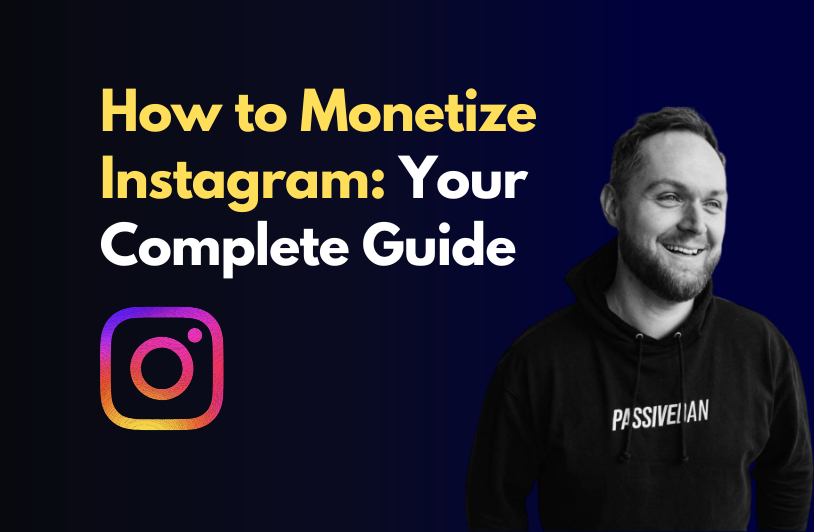Before you can even think about making a dollar on Instagram, you need to get your house in order. It all starts with building an account that people actually want to follow, one that pulls in a community and looks legit to potential brand partners. This means picking a profitable niche, dialing in your profile, and pumping out content that makes people trust you.
Building a Foundation for Monetization
Turning your Instagram into a money-maker isn’t just about chasing follower numbers. So many creators get hung up on that, but the real secret is building an engaged community that actually listens to you. Honestly, a smaller, dedicated audience that trusts your recommendations is way more valuable than a huge, silent one.
This initial setup is where you lay all the groundwork for everything that comes later, whether it’s affiliate marketing or selling your own stuff.
And the opportunity is massive. Instagram has over 2 billion monthly active users, with the sweet spot—the 18-34 age group—making up over 60% of that audience. In 2024, marketers in the U.S. alone are expected to drop $2.56 billion on Instagram influencer marketing. The money is there for creators who build their accounts the right way. If you want to dive deeper into the numbers, you can explore these Instagram marketing statistics.
Define Your Profitable Niche
Your niche is just the specific topic you’re going to talk about. It’s the absolute cornerstone of your whole strategy. A clear niche helps you attract the right kind of follower—someone who’s genuinely into what you have to say and, more importantly, might actually buy what you recommend.
Choosing a good niche comes down to a mix of three things:
- Passion: You have to actually like the topic. Authenticity is everything on Instagram, and your audience can spot a fake a mile away.
- Expertise: You don’t need to be the world’s #1 expert, but you need to know enough to give your followers real value.
- Profitability: Is there an audience here with money to spend? Look for niches that already have products, services, and brands doing business.
Some of the most profitable niches right now are personal finance, fitness, sustainable living, pet care, and even super-specific hobbies like digital art or homebrewing. If you’re stuck trying to figure this out, we have a whole guide on how to find your niche that walks you through it.
Optimize Your Profile for Business
Think of your Instagram profile as your digital storefront. It’s the first impression you make on a potential follower, brand partner, or customer. Every single part of it needs to be set up to show your value and tell people what to do.
Key Takeaway: Your Instagram bio is your elevator pitch. You’ve got 150 characters to tell people who you are, what you do, who you help, and what they should do next. Don’t waste it.
Here’s a quick checklist to get your profile ready:
- A Professional Profile Picture: Use a clean, high-quality headshot or a sharp brand logo. No blurry or generic photos.
- A Keyword-Rich Name: Stick a keyword about your niche in your name field (not just your @username). For example, “Jenna | Gluten-Free Recipes” tells people more than just “Jenna.”
- A Compelling Bio: Be super clear about your mission and who you’re for. A few emojis can add personality and break up the text.
- A Clear Call-to-Action (CTA): Literally tell people what to do next. “👇 Shop my favorite tools,” “📧 DM for collabs,” or “🚀 Join my free course” all work well.
- A Strategic “Link in Bio”: This is your most important piece of digital real estate. Use a tool like Linktree or Stan Store to create a landing page with links to all your important stuff—affiliate products, your website, or digital downloads.
Before you jump into the monetization strategies, it’s worth taking a moment to see if your account is actually ready. A strong foundation makes everything that follows ten times easier.
Instagram Monetization Readiness Checklist
This quick checklist will help you evaluate if your Instagram profile is primed for making money. It covers the essentials from your basic setup to your content strategy. Go through each item to see where you stand.
| Checklist Item | Why It Matters for Monetization | Status (Ready / In Progress) |
|---|---|---|
| Switched to a Professional Account | Unlocks crucial analytics and contact features needed for brand deals. | |
| Clear, Profitable Niche Defined | Attracts a targeted audience that brands want to reach and customers want to buy from. | |
| Fully Optimized Profile Bio with CTA | Your bio is your storefront. It needs to convert visitors into followers and customers. | |
| High-Quality, On-Brand Profile Photo | Establishes credibility and makes your profile instantly recognizable. | |
| Consistent Posting Schedule (3-5x/week) | Keeps your audience engaged and signals to the algorithm that your account is active. | |
| High Engagement Rate (3%+ is a good start) | Proves you have an active, loyal community—the #1 thing brands look for. | |
| “Link in Bio” Tool is Set Up | This is your primary sales channel. It must be organized and ready to direct traffic. | |
| Understanding of Your Audience Demographics | You can’t sell effectively if you don’t know who you’re selling to. |
Once you can confidently check off most of these items as “Ready,” you’re in a great position to start implementing the monetization tactics we’ll cover next. If you’re still “In Progress” on a few, focus on shoring those up first.
Driving Income with Affiliate Marketing
For many creators, affiliate marketing is the first real taste of making money on Instagram. And honestly, it makes sense. You don’t need a crazy huge following to get started, and there’s no need to invent your own product.
At its core, you’re just earning a commission for recommending products or services you already use and genuinely like.
The whole thing is pretty simple. You team up with a brand, they give you a special tracking link, and you share it. When someone in your audience clicks that link and buys something, you get a slice of that sale. It’s a win-win that rewards you for the trust you’ve already built.
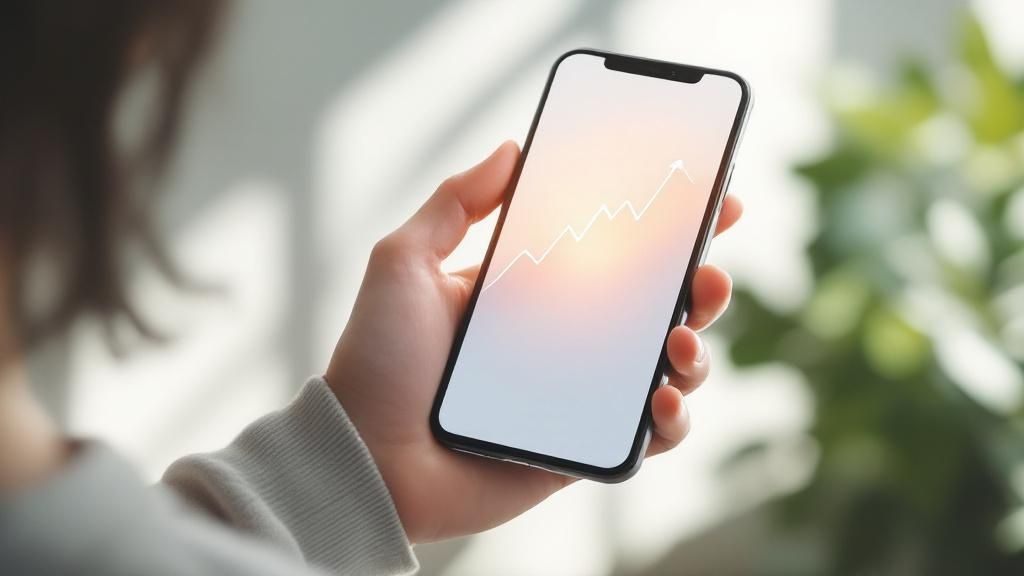
Finding and Partnering with Quality Affiliates
The absolute key to making affiliate marketing work is authenticity. If you start pushing random products, that trust you’ve worked so hard to build will disappear fast. The only way to win is to focus on brands that actually fit your niche and that you can personally stand behind.
So, where do you find these partners?
- Brand Websites: A lot of companies have an “Affiliates” or “Partners” link tucked away in their website footer. It’s always worth a look for brands you love.
- Affiliate Networks: Think of platforms like ShareASale, CJ Affiliate, and Rakuten Marketing as the middlemen. They connect you with thousands of brands looking for creators just like you.
- Your Go-To Products: What do you use every day? The tools, software, or gear that are essential to your life? Go look them up. There’s a good chance they have a program you can join.
Pro Tip: Don’t get blinded by a high commission rate. A 10% commission on a high-value item your audience actually needs is way better than a 50% cut of something cheap they’ll never buy. Always think about relevance and reputation first.
Integrating Links Authentically
Just spamming your links everywhere is a surefire way to get ignored. The real magic happens when you weave your recommendations into your content so it feels natural and helpful. The goal is always to provide value first, sell second.
Create content that solves a problem, with the affiliate product being the perfect solution. A fitness creator might post a Reel showing a workout with specific resistance bands, then link to those bands in their Stories. A food blogger could share a killer recipe and link to the exact air fryer they used to get that perfect crisp.
I cover these strategies in a lot more detail in my guide on affiliate marketing for content creators.
Examples of Effective Affiliate Marketing in Action
Let’s look at how successful creators pull this off. They aren’t just dropping links; they’re building entire systems around their affiliate strategy.
Using Stan Store for Digital Products and Links
Many creators use “link in bio” tools to keep their important links organized. Stan Store is a favorite because it’s also a digital storefront. For example, business strategist Jenna Kutcher is a master at this. Her Stan Store mixes affiliate links for tools she trusts (like her favorite business software) right alongside her own digital products, like photo presets and online courses. This makes her bio a one-stop-shop for monetization.
Selling High-Ticket Products
Pushing high-ticket items can be seriously profitable. Imagine a tech reviewer who recommends a specific camera or laptop. A single sale could mean a huge commission. The trick here is creating deep, trust-building content—think detailed reviews, tutorials, and side-by-side comparisons that really show why the higher price is worth it.
Lauryn Evarts Bosstick of The Skinny Confidential is a perfect example. She seamlessly works affiliate links for everything from high-ticket skincare gadgets to wellness supplements into her content, all neatly organized on a custom landing page. Her audience trusts her recommendations because they know she actually uses and vets every single thing she talks about.
Selling Digital Products as an Affiliate
Digital products—like software, online courses, and e-books—are goldmines for affiliates. Because there are no manufacturing costs, commission rates are often sky-high, sometimes 30-50% or even more. This is huge in the online business and marketing niches, where creators become affiliates for tools like ConvertKit or Canva Pro.
Ultimately, mastering affiliate marketing on Instagram comes down to building a solid system based on trust and value. For a deeper dive, check out this comprehensive guide to Instagram affiliate marketing success.
Securing Profitable Brand Partnerships
Affiliate marketing is a great way to get your feet wet, but the real game-changer for many creators is landing direct brand partnerships. This is where you graduate from earning small commissions to commanding flat fees for your content and influence.
Getting these deals is a mix of being discoverable and being proactive. Brands are always on the hunt for creators who have a genuine connection with their target audience. Your job is to make your profile a no-brainer for them by having a clear niche, a professional setup, and an audience that actually listens to you.
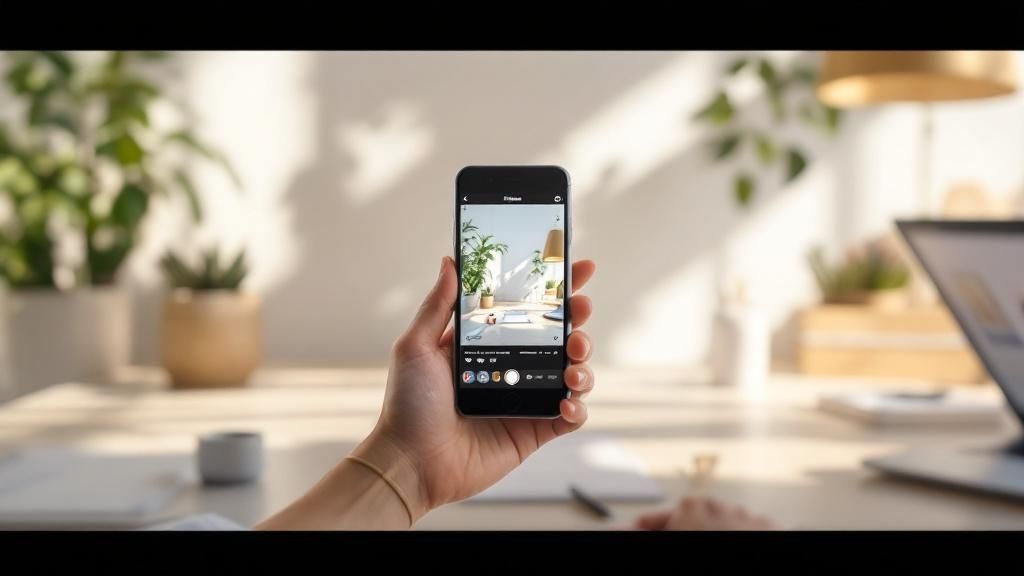
Crafting Your Professional Media Kit
Before you even think about sending that first email, you need a media kit. Think of it as your resume for the creator world. It’s usually a simple 2-3 page PDF that spells out exactly what you bring to the table.
Make it clean, visually appealing, and easy to scan. Brands are busy, so get straight to the point.
Here’s what you absolutely need to include:
- A Quick Bio: Who are you and what’s your page all about? Keep it short and sweet.
- Key Stats: Follower count, average reach, impressions, and—most importantly—your engagement rate.
- Audience Demographics: Who follows you? Age, gender, top locations, and their interests. You can pull all of this straight from your Instagram Insights.
- Past Collaborations: If you have any, show them off. Logos or quick case studies work great.
- Services & Rates: Clearly list what you offer (e.g., a dedicated post, a set of Stories, a Reel) and your starting prices.
- Contact Info: Don’t make them hunt for your email address.
Key Takeaway: Your media kit isn’t just a list of numbers; it’s a sales pitch. Frame your stats to tell a story about how your unique audience can help a brand hit its goals.
Understanding Your Market Value and Setting Rates
This is the part where most creators get stuck. How much do you charge? The old “$100 per 10,000 followers” rule is long dead. Today, your rate depends far more on your engagement, your niche, and the production quality of your content.
The numbers reflect this. A 2024 survey found that nano-influencers (500 to 10,000 followers) can pull in $500 to $2,000 per post. Micro-influencers (10,000 to 50,000 followers) often command $2,000 to $8,000. For macro-influencers, that figure can easily jump to $45,000 or more.
Don’t undervalue yourself. Start with a rate that feels fair for the work involved and be prepared to adjust as you gain more experience and your account grows.
Pitching Brands and Negotiating Deals
Once your media kit is polished, it’s time to go on the offensive. Don’t just sit around waiting for brands to find you. Create a dream list of companies you genuinely love and that make perfect sense for your audience.
Your pitch email should be short, personal, and focused on the value you offer them.
- Introduce Yourself: Briefly say who you are and why you’re a fan of their brand (be specific!).
- State Your Idea: Don’t just say “let’s collab.” Propose a specific content idea that shows you’ve done your homework.
- Show Your Value: Drop one key statistic about your audience that aligns perfectly with their ideal customer.
- Attach Your Media Kit: End with a clear call to action, like inviting them to review your attached media kit to discuss a potential partnership.
Landing profitable partnerships is a skill, and it takes practice. For a deeper dive into the strategies that work, learning from experts on how to get brand deals can give you a serious edge. It’s all about combining solid preparation with confident outreach.
Selling Your Own Digital and Physical Products
Affiliate marketing and brand deals are great, but if you want real control over your income, nothing beats selling your own products. This is where you graduate from being a promoter to a full-blown business owner, calling the shots on everything from pricing and branding to your profit margins.
You’re building an independent business on the foundation of the community you’ve already built. Forget taking a small commission—you keep 100% of the profits. This is the leap from influencer to entrepreneur.
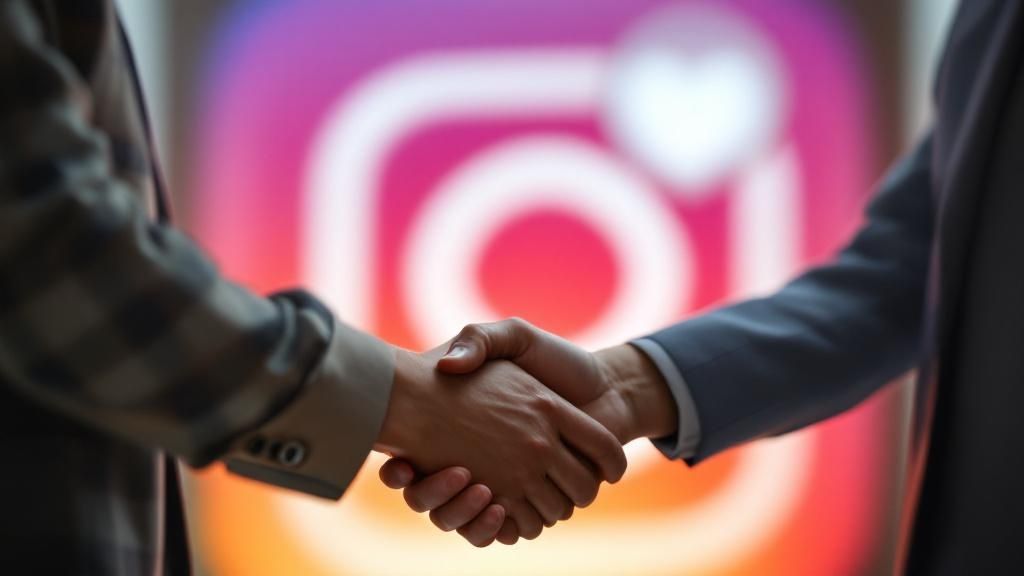
Capitalizing on Digital Products
For creators just dipping their toes into selling, digital products are a fantastic place to start. The profit margins are incredible because you have zero inventory costs, no shipping headaches, and no manufacturing to worry about. You make it once, and you can sell it forever.
It’s the perfect model for packaging your specific knowledge to solve a real problem for your audience.
Here are a few popular ideas:
- Ebooks and Guides: Got deep knowledge on a topic? Write it down. A personal finance creator could sell a “Beginner’s Budgeting Bible,” or a travel influencer might offer a detailed “7-Day Tokyo Itinerary.”
- Presets and Templates: If your followers love your aesthetic, sell it. Photographers cash in on Lightroom presets, and productivity gurus sell Notion templates. It’s a no-brainer.
- Online Courses: For heavier topics, a structured course offers massive value. Think of a fitness influencer launching a “30-Day Home Workout Challenge” course.
The secret is to create something that solves a pain point your audience won’t shut up about. Pay attention to your DMs and comments. Your followers are literally telling you what they will pay you for.
Real-World Example: Selling Digital Guides
Look at someone like Amanda Frances. She’s built a powerhouse business by using Instagram to share insights on manifestation and money mindset, which seamlessly funnels her audience into her library of digital courses and guides.
Her content isn’t just a sales pitch; it provides genuine value and builds her authority. That way, when she introduces a product, it feels like a natural solution, not a hard sell. She’s a master at using Instagram Stories to talk about the transformations her products deliver, which is way more powerful than just listing what’s inside.
Venturing into Physical Products
Okay, so physical products mean dealing with logistics, but they also let you put something tangible in your followers’ hands. This could be anything from branded merch to a handmade item that fits your niche perfectly.
Here are the most common ways creators get started:
- Merchandise: If you have a strong personal brand and a loyal following, selling merch like t-shirts, hats, or mugs is a great move. Use platforms like Sellfy or Printful to handle all the printing and shipping, which means almost no upfront risk for you.
- Dropshipping: This is a popular one. You market products from a supplier who handles all the inventory and shipping. You can offer a huge variety of products without ever having to touch the stock yourself.
- Your Own Product Line: This is the big league, but it offers the highest reward. It’s a common path for creators in beauty, fashion, or food who build up enough demand to launch their own unique product.
Building Your Instagram Sales Funnel
It doesn’t matter if your product is digital or physical; you need a system to turn your followers into paying customers. Your Instagram account is the sales funnel.
- Awareness: Your Reels, carousels, and Stories are your top of funnel. Create content that attracts your ideal buyer by showcasing your expertise or the lifestyle tied to your products.
- Interest: Start teasing the solutions your products offer. Post behind-the-scenes content of you creating the product, share testimonials, or feature user-generated content from happy customers.
- Desire: This is where you make your offer irresistible. Use strong calls-to-action (CTAs) in your captions and Stories, pushing everyone to your “link in bio.” Scarcity tactics like limited-time offers work wonders here.
- Action: Time to close the deal. Your link-in-bio tool (whether it’s Stan Store or your own website) needs to be dead simple to use. Make sure the checkout process is smooth and mobile-friendly.
When you sell your own products, you’re building an asset that belongs to you. You’re no longer at the mercy of brand budgets or affiliate terms. You’re building a real, scalable business that generates income directly from the community you worked so hard to grow.
Monetizing Your Expertise with High-Ticket Services
While products are a great way to make money, selling your expertise directly is often where the real profit is. If you’re a coach, consultant, or freelancer, Instagram can be more than just a place to post content—it can become your primary client-getting machine for high-ticket services.
This is all about shifting from one-off sales to building a serious business around high-value transformations. You’re not just selling your time; you’re selling a result.
Positioning Yourself as an Expert
To attract clients willing to pay premium prices, your content needs to scream expertise. You have to move past sharing random tips and start showcasing a distinct point of view and a proven method. Every single post, Reel, and Story should be working to build your authority and earn trust.
Think about organizing your content around pillars that hit the biggest pain points for your ideal client. For instance, a business coach might focus on:
- Mindset Shifts: Tackling the mental roadblocks that keep entrepreneurs stuck.
- System Breakdowns: Sharing frameworks for boosting efficiency and profit.
- Success Stories: Using client wins and testimonials as powerful social proof.
The idea is to make your free content so valuable that followers start thinking, “If this is what I get for free, imagine the results I’d get if I paid.”
From DMs to Discovery Calls
The real work often happens in the DMs. This is your chance to shift from being a broad content creator to a one-on-one problem solver. A great way to start this is by using your calls-to-action (CTAs) to invite interested followers to DM you a specific keyword to get more info.
Once they’re in your DMs, resist the urge to sell right away. The goal here is to qualify them and gently guide them toward a discovery call.
Your DMs are for conversation, not conversion. Ask thoughtful questions to understand their challenges. If it feels like a good fit, invite them to a “no-pressure strategy call” to explore how you can help. This approach feels helpful, not salesy.
If you’re looking for a deeper dive into building a business around your personal brand, a mentorship program can offer solid frameworks for structuring these kinds of high-ticket offers.
Crafting and Closing High-Ticket Offers
A high-ticket offer isn’t just a service; it’s a complete solution to a big, nagging problem. It needs to be packaged as a program that promises a specific, desirable transformation. So, instead of selling “hourly coaching,” you’re selling a “90-Day Business Accelerator Program” that guarantees clarity and a roadmap for growth.
Business strategist Jasmine Star is a perfect example of this in action. Her content consistently educates her audience, cementing her status as an expert. She uses Instagram to build a community of entrepreneurs who are then eager to sign up for her high-ticket coaching programs.
Using Instagram’s Built-In Monetization Features
While brand deals and selling your own stuff are great, don’t sleep on the tools Instagram has built right into the app. These are native features designed to help you earn money without ever forcing your followers to leave Instagram. Think of it as a more direct, seamless way to generate income.
Honestly, these tools are Instagram’s way of investing back into people like us. By using them, you can add more streams of income to your strategy, making you less reliant on any single source.
Tap into Recurring Revenue with Subscriptions
Instagram Subscriptions are a game-changer. They let your most loyal followers pay a monthly fee for exclusive content and other perks. What’s so great about this? It creates a predictable, recurring revenue stream—something you just don’t get from one-off brand deals.
You’re in the driver’s seat here. You set the monthly price and decide what exclusive goodies your subscribers get. This could be things like:
- Subscriber-only content: Think exclusive posts, behind-the-scenes Stories, special Reels, and even private Lives.
- Exclusive chat channels: This gives you a direct line to your most dedicated fans. It’s community building at its best.
- Special badges: Subscribers get a unique badge next to their name in your comments and DMs, making them feel like true VIPs.
This whole model turns your most engaged followers into paying members of an exclusive club, rewarding them for sticking with you.
Earn with Creator Bonuses and Incentives
From time to time, Instagram runs incentive programs that pay creators directly for hitting certain performance goals. The most famous one is the Reels Play Bonus Program, which rewarded creators based on how many views their Reels racked up. It was often invite-only, but it’s a solid example of how the platform is willing to pay for content that keeps people on the app.
Making money from Reels has become a pretty big deal, especially with programs that reward you for hitting view milestones. With Reels getting an average view rate of 10.53%, it’s clear why Instagram is pushing them so hard. As the platform rolls out more of these opportunities, it’ll become easier to monetize your content directly, right alongside sponsorships and the Instagram Creator Marketplace. For a deeper dive, you can discover the full details on Instagram monetization features.
Here’s a quick look at how different monetization methods can stack up in terms of average monthly earnings.
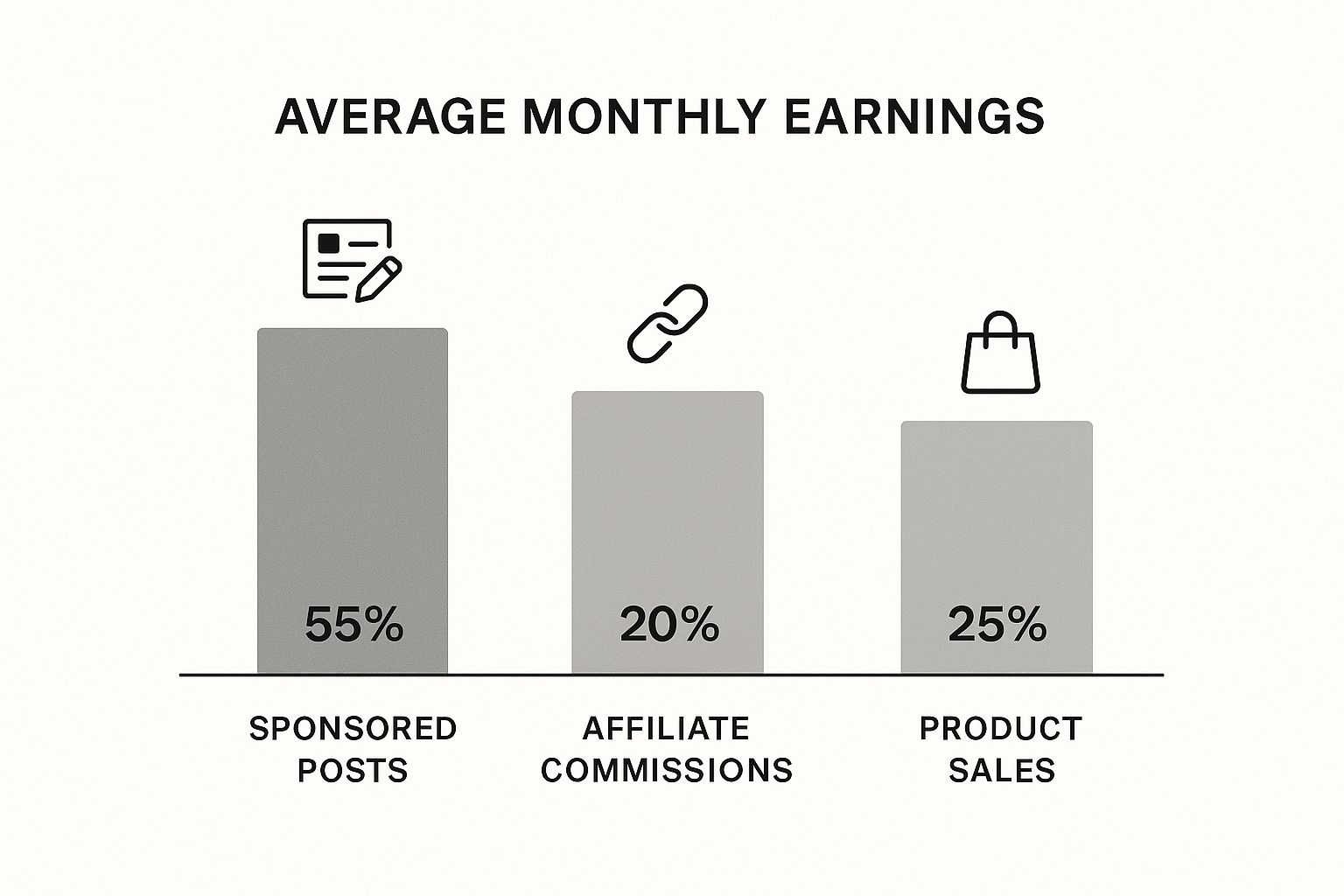
As you can see, while every method has its place, selling your own products often comes out on top for earning potential.
To help you decide which path is right for you, I’ve put together a quick comparison of the most common monetization methods on Instagram. This should give you a clearer picture of the effort involved versus the potential reward.
Comparison of Instagram Monetization Methods
| Monetization Method | Income Potential | Effort Level | Best For (Follower Level) |
|---|---|---|---|
| Affiliate Marketing | Medium | Medium | Micro-influencers (10K+) |
| Sponsored Posts | High | Medium | Macro-influencers (100K+) |
| Selling Own Products | Very High | High | All levels, especially established brands |
| Instagram Subscriptions | Medium | Low to Medium | Creators with highly engaged communities (5K+) |
| Instagram Bonuses | Low to Medium | Low | Varies (often invite-only) |
This table isn’t an exact science, but it’s a good starting point. The “best” method really depends on your niche, your audience, and how much time you’re willing to put in. Don’t be afraid to mix and match a few of these to see what works for your account.
Getting Started with Native Tools
To get access to these features, you’ll need to meet Instagram’s eligibility requirements. This usually means having a creator or business account, a certain number of followers, and following their Partner Monetization Policies. They’re pretty straightforward.
Actionable Tip: Check if you’re eligible by heading to your Professional Dashboard in the app. If you qualify for features like Subscriptions or Bonuses, you’ll see the setup options right there. It pays to be proactive and check this space often, since Instagram is always changing things up.
By layering these built-in tools into your strategy, you build a much more stable financial foundation for your brand. You stop relying solely on outside deals and start making money directly from the platform you already spend so much time on.
Got Questions About Making Money on Instagram?
So, you’re thinking about turning your Instagram into an income stream. It can feel like a bit of a maze when you’re starting out, moving from just building a community to actually earning from it. A few questions always seem to pop up right at the beginning.
Let’s clear the air and tackle the most common ones I hear from creators.
How Many Followers Do I Really Need?
This is the big one, isn’t it? Everyone wants to know the magic number. But here’s the truth: you absolutely do not need 100,000 followers to start earning.
I’ve seen nano-influencers (that’s anyone with 1,000-10,000 followers) with incredible engagement rates do really well. Why? Because they’re super attractive to brands.
Engagement trumps follower count every time. A small, dedicated audience that genuinely trusts what you say is far more valuable than a huge, silent one. Brands know this. They’d often rather work with smaller creators who have a real connection with their community. You can start with affiliate marketing or sell a simple digital product with just a few thousand loyal fans.
What Are My Legal Responsibilities?
Once you start making money, you’ve got to think about the legal side of things. The number one rule is transparency. You have to be crystal clear when your content is sponsored or when you’re using affiliate links.
Hiding it isn’t just shady—it’s against the law in many places, like the FTC guidelines in the US.
The standard way to do this is with hashtags like #ad, #sponsored, or #affiliatelink. Instagram also has a “Paid Partnership” label built right in, which you should definitely use for any brand collaborations. Being upfront protects you and, more importantly, keeps the trust you’ve worked so hard to build with your audience.
How Long Does It Take to Make Money?
Setting realistic expectations here is probably the most important thing you can do to avoid burning out. Monetizing your Instagram is a marathon, not a sprint. The timeline for earning a decent income can vary wildly.
A few things will affect how quickly you see results:
- Your Niche: Some niches, like personal finance or tech, often monetize faster than broader lifestyle or entertainment accounts.
- Your Strategy: Focusing on high-ticket coaching services might bring in cash faster than relying on small commissions from low-cost affiliate products.
- Your Consistency: This is huge. The quality of your content, how often you post, and how much you engage with your community directly impact how quickly you can build an audience that’s ready to buy.
Honestly, for most people, it takes several months of consistent work to see their first few dollars. It often takes a year or more to build a steady, reliable income stream. Focus on giving value and building a real community first—the money will follow.
Ready to stop guessing and start building a real affiliate marketing business? At Daniel Proctor, we provide the mentorship and step-by-step frameworks to shorten your path to profitability. Learn more about our programs and get started today.

